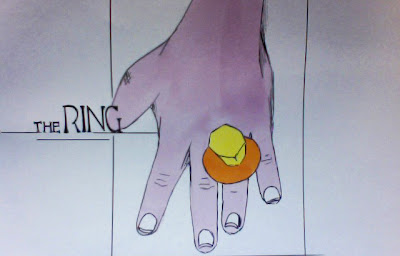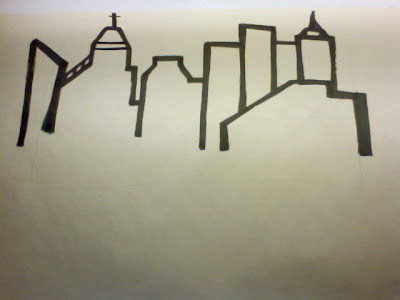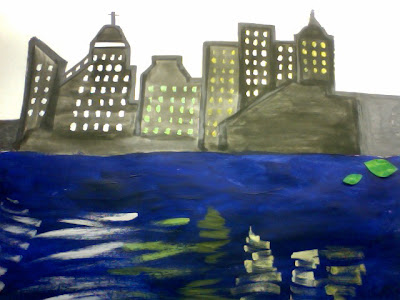Innovations- Graphic Design/Illustration
Tuesday, 11 January 2011
Wednesday, 29 December 2010
Tomar Hanuka.
Illustrator Tomer Hanuka has published some of his rejected New Yorker cover ideas for 2010, some of which went as far as a final without publishing.
I am in love with this guys work! Really want to try to re-create it as Valentine's cards somehow. His work is fantastic. He uses pencils for his initial sketching then colours it with Illustrator. I love the autumny colours he uses and the simple graphics. I think it all works really well against the 'New Yorker' text as I really like the font.
I am in love with this guys work! Really want to try to re-create it as Valentine's cards somehow. His work is fantastic. He uses pencils for his initial sketching then colours it with Illustrator. I love the autumny colours he uses and the simple graphics. I think it all works really well against the 'New Yorker' text as I really like the font.
Thursday, 2 December 2010
Wednesday, 1 December 2010
Happy Valentines. Illustration?
For this brief I think I will use mostly Illustration... I will sketch the images I want to use for my Valentine's cards and then use software such as PhotoShop or Illustrator to colour them in!
I have researched some illustrators whose work I really like.
I have researched some illustrators whose work I really like.
I like the idea of using pencil... back to basics, keeps it simple but yet effective too and easy to dress up with text and background colours.
Tuesday, 30 November 2010
What is love?
What exactly is the “What is Love...” design challenge?
We are looking for talented designers to submit concept-driven designs for our 2011 Valentine’s Day Greeting Card collection. Templates, color swatches, font lists and design direction will be provided to everyone who registers for the challenge. There is no registration fee. To register, please send an email with a quick introduction and contact information to whatislove@tinyprints.com by Friday, November 26, 2010 at 9:00 am PST.
What is love?
cupid. valentines. hugs and kisses. family. friends. sex.weddings. marraige. warmth. comfort. pain. companionship. laughter. children.
We are looking for talented designers to submit concept-driven designs for our 2011 Valentine’s Day Greeting Card collection. Templates, color swatches, font lists and design direction will be provided to everyone who registers for the challenge. There is no registration fee. To register, please send an email with a quick introduction and contact information to whatislove@tinyprints.com by Friday, November 26, 2010 at 9:00 am PST.
What is love?
cupid. valentines. hugs and kisses. family. friends. sex.weddings. marraige. warmth. comfort. pain. companionship. laughter. children.
Wednesday, 24 November 2010
Sunday, 21 November 2010
Friday, 19 November 2010
Setting the scene...
I created the scene for the 'Nature Takes Over' video simply by drawing on to a blank page and using stop motion to take photos of each step (to create an animated effect).
I painted a sky-line back drop, then used cut-outs of leaves to fall over the scene and then painted over the scene with trees:
I painted a sky-line back drop, then used cut-outs of leaves to fall over the scene and then painted over the scene with trees:
Monday, 15 November 2010
Sunday, 14 November 2010
Idea.
I would like to try my hand at a video to show the idea of trees taking over a city, perhaps invading some sort of sky-line (new york or australia etc). I think the best way to do this would be shadow animation.
Some good examples I found of shadow animation, related to my idea, on the Internet:
http://www.myspace.com/video/vid/35003249
http://www.youtube.com/watch?v=yWhl5VU0pKQ
Some good examples I found of shadow animation, related to my idea, on the Internet:
http://www.myspace.com/video/vid/35003249
http://www.youtube.com/watch?v=yWhl5VU0pKQ
Wednesday, 10 November 2010
My Photography...
Trying to incorporate agriculture (trees) and industry (buildings), using photography and layering photographs.
Monday, 8 November 2010
When trees attack
http://woondu.com/really-unusual-trees/
I like the idea of Trees taking over the city, as it incorporates agriculture and a greener environment into urban culture.
Why are trees important?
[taken from forestry.about.com]
1. Trees Produce Oxygen
Let's face it, we could not exist as we do if there were no trees. A mature leafy tree produces as much oxygen in a season as 10 people inhale in a year. What many people don't realize is the forest also acts as a giant filter that cleans the air we breath.2. Trees Clean the Soil
The term phytoremediation is a fancy word for the absorption of dangerous chemicals and other pollutants that have entered the soil. Trees can either store harmful pollutants or actually change the pollutant into less harmful forms. Trees filter sewage and farm chemicals, reduce the effects of animal wastes, clean roadside spills and clean water runoff into streams.
3. Trees Control Noise Pollution
Trees muffle urban noise almost as effectively as stone walls. Trees, planted at strategic points in a neighborhood or around your house, can abate major noises from freeways and airports.4. Trees Slow Storm Water Runoff
Flash flooding can be dramatically reduced by a forest or by planting trees. One Colorado blue spruce, either planted or growing wild, can intercept more than 1000 gallons of water annually when fully grown. Underground water-holding aquifers are recharged with this slowing down of water runoff.5. Trees Are Carbon Sinks
To produce its food, a tree absorbs and locks away carbon dioxide in the wood, roots and leaves. Carbon dioxide is a global warming suspect. A forest is a carbon storage area or a "sink" that can lock up as much carbon as it produces. This locking-up process "stores" carbon as wood and not as an available "greenhouse" gas.6. Trees Clean the Air
Trees help cleanse the air by intercepting airborne particles, reducing heat, and absorbing such pollutants as carbon monoxide, sulfur dioxide, and nitrogen dioxide. Trees remove this air pollution by lowering air temperature, through respiration, and by retaining particulates.7. Trees Shade and Cool
Shade resulting in cooling is what a tree is best known for. Shade from trees reduces the need for air conditioning in summer. In winter, trees break the force of winter winds, lowering heating costs. Studies have shown that parts of cities without cooling shade from trees can literally be "heat islands" with temperatures as much as 12 degrees Fahrenheit higher than surrounding areas.8. Trees Act as Windbreaks
During windy and cold seasons, trees located on the windward side act as windbreaks. A windbreak can lower home heating bills up to 30% and have a significant effect on reducing snow drifts. A reduction in wind can also reduce the drying effect on soil and vegetation behind the windbreak and help keep precious topsoil in place.Thursday, 4 November 2010
What is 'Green' Space/?
"Going green" can mean literally just that -- turning your community green with foliage. And green space is exactly what it sounds like: It's the amount of open space reserved for plants and trees, gardens, parks and nature preserves. Green space improves air quality, cuts pollution levels and energy costs, and adds to the aesthetic of the city.
Some cities are finding innovative ways to include green space in their urban landscape. In 2000, the city of Chicago planted a garden in place of the black tar roofing on a city government building. Green roofing offers similar benefits to gardens and parks at ground level by helping to reduce urban heat islands. Green rooftops also add a layer of insulation to the building, keeping it warmer in the winter and cooler in the summer, reducing the building's energy costs.
[http://mtamazingfact.blogspot.com]
Some cities are finding innovative ways to include green space in their urban landscape. In 2000, the city of Chicago planted a garden in place of the black tar roofing on a city government building. Green roofing offers similar benefits to gardens and parks at ground level by helping to reduce urban heat islands. Green rooftops also add a layer of insulation to the building, keeping it warmer in the winter and cooler in the summer, reducing the building's energy costs.
[http://mtamazingfact.blogspot.com]
Wednesday, 3 November 2010
Combining Urban & Agricultural.
[www.greenzone.com]
The city I design needs to combine both urban elements, and agricultural.
[www.weburbanist.com]
Tuesday, 2 November 2010
Monday, 1 November 2010
Cityscape Art.
Researching cityscape artists to get ideas on how to display what my 'city of the future' will look like.
Tree Hugger!
Tree Hugger website.
I found the www.treehugger.com website very interesting and useful when researching this project, especially for gathering more information about how to reduce carbon footprint in modern-day living, and ways we can help to save the environment and make our world greener.
I specifically like the 'Design & Architecture' section, which is most relevant to this brief:
I found the www.treehugger.com website very interesting and useful when researching this project, especially for gathering more information about how to reduce carbon footprint in modern-day living, and ways we can help to save the environment and make our world greener.
I specifically like the 'Design & Architecture' section, which is most relevant to this brief:
- Future Green Cities:
- City Planning for the car-free future:
- Underwater cities:
Masdar City:
Subscribe to:
Comments (Atom)





























